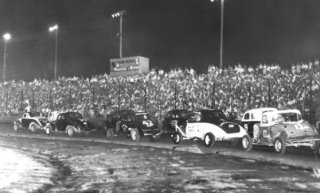
Rick Minter
By Rick Minter-Guest Columnist
Posted in Columns 2/5/10
Georgia’s had more than its share of famous race tracks over the years, but few have had the enduring magic of the one known as the Peach Bowl.
Last Sunday, for the 21st straight year, drivers, mechanics, owners, fans and friends of the Peach Bowl gathered in Riverdale for a gathering that is more like a family reunion than a racing affair.
The first reunion, held in a barbecue restaurant on the north side of Atlanta, drew about 100 people. Jack Jackson, a Peach Bowl veteran and the reunion’s organizer, said he got the idea for the gathering after attending the funeral of a fellow competitor. It seemed that the funeral home talk was dominated by stories of the Peach Bowl.
The reunion was just the ticket for racers who had gone their separate ways for the most part after the track closed.
Over the years, many of the attendees at the first reunion have passed away. But their survivors continue to attend the reunion, and now the crowd generally numbers more than 200.

Opened in 1949 in Atlanta, the Peach Bowl soon became a mainstay in Georgia auto racing. Despite closing in 1971, the track remains a part of Georgia racing legend.
The success of the reunion shows that the little quarter-mile track and the relationships it fostered still have a big place in the hearts of its participants.
“I don’t have to call people to get them to come,” Jackson said. “They come because they want to be here.”
The Peach Bowl’s alumni roster reads like a Who’s Who of early stock car racing. Red Byron, the first champion of the circuit now known as Sprint Cup, raced there in a Midget early on. One of the Peach Bowl’s most dominating drivers, Jack Smith, went on to win 21 Cup races and earn a spot in the Stock Car Hall of Fame at Darlington. Rex White, the 1960 Cup champion, was a Peach Bowl veteran as were Gober Sosebee and Roscoe Thompson, two early NASCAR stars. In later years, Bobby and Donnie Allison were among the Cup stars who raced at the Peach Bowl.
NASCAR founder Bill France Sr. promoted races there in the early 1950s, and it was at his suggestion that the track was converted from dirt to asphalt.
The Peach Bowl also had its share of amateur drivers, who became crowd favorites and helped fill the grandstands every week.
Few amateurs pleased the crowd more than Jackson, the reunion organizer.
Just like in the days when the Peach Bowl was running, the reunion crowd includes both professional racers and amateurs.
White, the 28-time Cup winner, recalled leading 300 laps of a 400-lap NASCAR Short Track Division race at the Peach Bowl in the late 1950s only to burn out a right front wheel bearing.
Harvey Jones, the legendary racing mechanic from Atlanta, shared tales of his days on the early NASCAR circuit as well as the nights he prepared cars at the Peach Bowl.
Those seated at one table showed just how many race drivers the mill town of Griffin produced. There was Roscoe Smith and his son Clint, Leon Archer, David Castille and Kenneth Collins.
Georgia’s Who’s Who of racing announcers were there too. There was Jimmy Mosteller, the voice of the Peach Bowl and countless other Georgia tracks. And Johnny Clark, whose booming voice is familiar to fans at Dixie and Rome Speedways as well as to drag racing fans from the old strip in Dallas. And Captain Herb Emory, known to most for his racing show and traffic reports on WSB Radio, but also a former track announcer at West Atlanta Raceway in Douglasville.

Fans and drivers get ready for an event at the Peach Bowl in 1953.
Jackson said the mixture of pros and Saturday night heroes, and racing people in general, during the Peach Bowl era and at the reunion wouldn’t have been possible without the leadership and vision of the Peach Bowl’s long-time promoter, the late Roy Shoemaker.
“Roy was the best promoter ever,” Jackson said. “I would have never gotten to race if he hadn’t started the amateur class. I couldn’t compete against guys like Jack Smith,”
But through racing at the same track, and through the long-running reunion, Jackson and other amateurs have gotten to know the NASCAR greats on a one-on-one basis.
Mike Bell, the leading racing historian in the Atlanta area, said Shoemaker left another legacy that’s often overlooked, even in a city known for its role in racial integration.
In the early 1960s, with no outside pressure and before the civil rights movement really got going, Shoemaker integrated the track, pushing the old “White” and “Colored” grandstands together and making them one. He opened the competition to anyone regardless of color, and advertised his races in the city’s black newspaper, The Atlanta Daily World.
“He did all that on his own,” Bell said.
And nearly 40 years after he promoted his last race, Shoemaker’s legacy is still being celebrated. And the everyday people he helped turn into local folk heroes still get to relive the thrills of victory, every last Sunday in January.
Rick Minter is an award-winning sports journalist who began covering motorsports for the The Atlanta Journal-Constitution in 1991, as well as serving as a bureau chief. Minter focused on racing exclusively from 2000-2008 . Minter and his wife Joanne live on the family farm in Inman, Georgia. In his spare time he collects and restores antique tractors and trucks.
Questions, comments, suggestions? Email us!
This website is not affiliated with or endorsed by the Georgia Racing Hall of Fame or the Georgia Auto Racing Hall of Fame Association, Inc. All content is the intellectual property of the individual authors. All opinions are those of the individual authors. Please do not repost images or text without permission.
